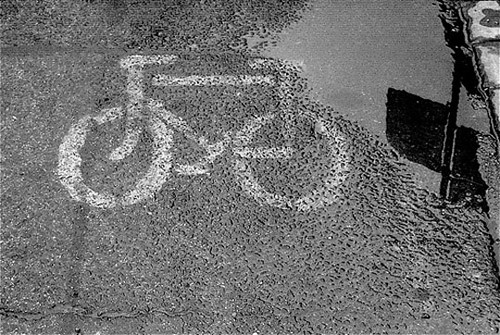
“Perhaps for the first time in North America since the invention of the automobile, road space for motor vehicles is being reallocated to bicycles,†wrote Andrew G. MacBeth in the Institute of Transportation Engineers Journal back in 1999. In the nine years since then, you’d think providing more pavement for cyclists would have gotten a lot easier, and perhaps it has (at least a bit). One thing that hasn’t changed, however, is the fear of what will happen if we trade in parking spaces for space for bikes. Wrote MacBeth back then: “loss of on-street parking is one of the most controversial issues associated with [the] implementation [of bike lanes].
Case in point is a new bike lane proposed for Annette Street (north of Bloor) between Jane and Lansdowne (it’s “new†in the sense that it’s just being debated now, but it’s been part of the bike plan for years.) According to World 19 (a Bloor West Village community group that’s backing the proposal), “City studies indicate there will be minimum negative impact due to loss of parking.†Still, at the first, and so far only, community consultation that has been held on the proposal, business owners strongly opposed the idea, decrying the loss of roughly half (according to one attendee) of the on-street parking spots that currently exist.
The solution crafted at the request local councillor Bill Saudercook would see the stretch of the bike lane between Jane and Runnymede moved north to St. Johns Road, causing the otherwise continuous east-west route to be disjointed.
“Losing Annette will be a huge blow in the effort to finally make real progress in bike lanes,†reads World 19’s website. “An overall bike network that has routes which divert north, south, east and west when it would pass a modest number of commercial properties is NOT acceptable.â€
It’s easy for most people to imagine how getting rid of on-street parking could be bad for businesses along a commercial strip, which is probably why despite a study that found that the impact on businesses would be minimal, Councillor Saundercook, a self-described “strong supporter†of the bike plan, was moved to look for alternate possibility. But what about the alternative: could increased cycling traffic have a positive impact on business that line bike lanes?
The proposal (which also includes new bikes lanes on Dupont street from Dundas West to Lansdowne Avenue) will be discussed at the Public Works and Infrastrcture Committee meeting this Wednesday, June 4. Those interested can download the staff report and recommendations [PDF] from the city’s website. Anyone wishing to make comments to the Committee, or to depute at their meeting, can contact Ros Dyers (rdyers (at) toronto.ca). Requests to make deputations are due Tuesday at noon.
Visit World 19’s “biking page” for more information on the Annette Street bike lane. The I Bike Toronto blog also covered the community meeting and posted regular updates and opinions from readers.
Photo by Martin Reis on Flickr




8 comments
The Councillor head of the new curtailed TCAC said at the last meeting that he wasn’t too worried about losing 1km as we’d make it up somewhere else – the logical place for me (and others) being in the Bloor St. rebuild of 1km that’s going on now between Ave. Rd. and Church St. where the City’s commitment to safe cycling goes as far as wide curb lanes, sharrows, and having the pavement wide enough that eventually we will get bike lanes.
The trouble is there’s a 16-year-old city study saying this wide part of Bloor was the #1 choice for east-west bike lanes. As the merchants who are paying for much of this project have already agreed to remove the parking from the street, usually the #1 obstacle to bike lanes on carterials, this is a once in fifty year opportunity to make something truly bike-friendly, but Heaps and some others almost seem resistant to sticking up for bicycles through here.
It is interesting to me that in the 19th century, the roads were just dirt in Toronto. Other than sidewalks, the only pavement were between the streetcar tracks, so the horses wouldn’t kick the dirt out creating a gully. Or there were cobblestones so the dirt may wash away in the rain.
Then the bicycle came around. Bicyclists kept petitioning the city for smooth asphalt over the dirt for easier travel. Guess what, they did. Except now, when more and more automobiles came on the scene, they found they had a ready made surface for them.
Be careful what you wish for. The smooth asphalt roads were originally for the benefit of bicycles, but were invaded by the automobile.
I rode on Annette last night and I thought it would make an ideal bike lane street. Currently, the road is in dire need of repaving, tho some has started near jane.
A few years ago Miller had his constituency office on Annette, and there was something not good, but as I rmember, his office didn’t know it was on the Bike Plan or maybe it was roads dept, likely the latter.
The reason Annette’s more on the agenda now maybe to ease pressures for east-west on Bloor, but it’s also due for repaving.
There’s a Big Question of whether we insist on having a decent standard of pavement ahead of having a bike lane put in as Wellesley was so rough, I was asking for its deferral until repairs were made. Staff have said they’ll fix it – but when? and how well?
And yes, we need to be careful for what we wish for.
Two of the reasons why we (at world19) feel the Annette lane issue is important are:
1. The precedent it will set for other similar routes on “light commercial” streets which would require removal of some parking. According to city staff, Annette would be unique in that regard. We don’t want to see future proposals divert around commercial and retail blocks.
2. The abysmal “public consulation” on which city staff/Councillor Saundercook based the recommended diversion.
The statement in the staff report that “The local community was given an opportunity to comment on
the proposal at a Public Open House held on April 17, 2008” is simply not true, given the fact that there was almost no public notice. The report concludes that “As a result of this community feedback the bikeway proposal was modified to eliminate the bicycle lanes between Jane Street and Runnymede Road.” What community feedback?
We’ve also updated our webpage on this issue (http://www.world19.com/bikes.htm) with more details about this and details on deputing or sending comments to the Committee. (Deadline Tuesday noon).
Annette would be an awesome bike lane location and in reality there is not that much commercial activity along it. Customers drive AND walk and bike.
I live on a street that runs between St. Johns Road and Annette and I disagree with Councillor Saundercook about jogging the last km north. Annette is such a good option for a bike lane street. It has the soon-to-be Rail Path at one end and a quick run through Baby Point to the Humber trail at the other. Is St. Johns even wide enough? You can barely pass two cars with parking on one side.
I agree, Annette is an ideal link to get from the coming rail path to the Humber trail. It would slow down the traffic and make it friendlier for local shopping.
Besides the spineless Saundercook, Kyle Rae is another “progressive” that is in the way of making a greener Toronto by blocking Bloor bike lanes in his ward. It’s time for fresh blood.